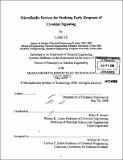Microfluidic devices for studying early response of cytokine signaling
Author(s)
Ye, Linlin, Ph. D. Massachusetts Institute of Technology
DownloadFull printable version (23.87Mb)
Other Contributors
Massachusetts Institute of Technology. Dept. of Chemical Engineering.
Advisor
Klavs F. Jensen.
Terms of use
Metadata
Show full item recordAbstract
This thesis presents the design, fabrication, and characterization of a microfluidic device integrated with cell culture, cell stimulation, and protein analysis as a single device towards an efficient and productive cell-based assay development. In particular, this thesis demonstrates the feasibility of culturing human cancer cells in microliter-volume reactors in batch and fed-batch operations, stimulating the cell under well-controlled and reproducible conditions at early stages, and detecting the protein signals with an immunocytochemical (In-Cell Western) assay. These microfluidic devices take advantage of microfabrication techniques to create an environment suitable for cell culture, biomechanical and biochemical stimulation of cells, and protein detection and analysis. The microfluidic approach greatly reduces the amounts of samples and reagents necessary for these procedures and the required process time compared with their macroscopic counterparts. Moreover, the technique integrates unit operations, such as cell culture, stimulation, and protein analysis, in a single microchip. The microfluidic technique presented in this thesis correlates the space in the microchannels with the biological process time (cell stimulation time). Thus, a single experiment in one microfluidic device is capable of generating a complete temporal cell response curve, which otherwise would have required multiple experiments and manual assays by standard microwells and pipetting techniques. The developed method also provides high time-resolution and reproducible data for studies of cell signaling events, especially at early stages. These cell signaling events are difficult to be investigated by conventional techniques. The thesis reports the development not only of a cell population analysis method, but also of a single-cell detection and analysis technique to explore cell-to-cell variations. (cont.) In this study, a new microscope stage holder was designed and machined, and an auto cell counting algorithm was developed for the single-cell analysis. This single-cell method provided data on cell-to-cell variations and showed that the average cell signaling profiles were consistent with those by population-based analysis. The integration of the single-cell imaging and microfluidic method enabled measurements shows promise as a technique for exploring the cell signaling with single-cell resolutions.
Description
Thesis (Ph. D.)--Massachusetts Institute of Technology, Dept. of Chemical Engineering, 2008. Includes bibliographical references (p. 111-125).
Date issued
2008Department
Massachusetts Institute of Technology. Department of Chemical EngineeringPublisher
Massachusetts Institute of Technology
Keywords
Chemical Engineering.